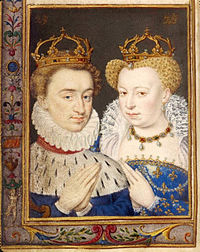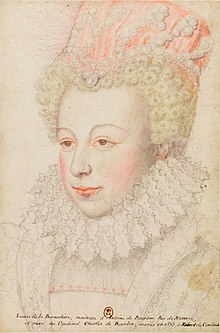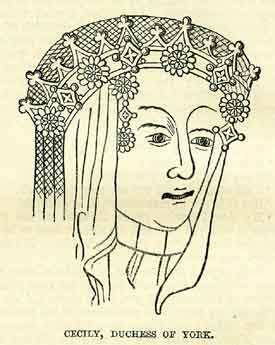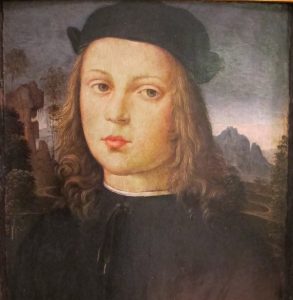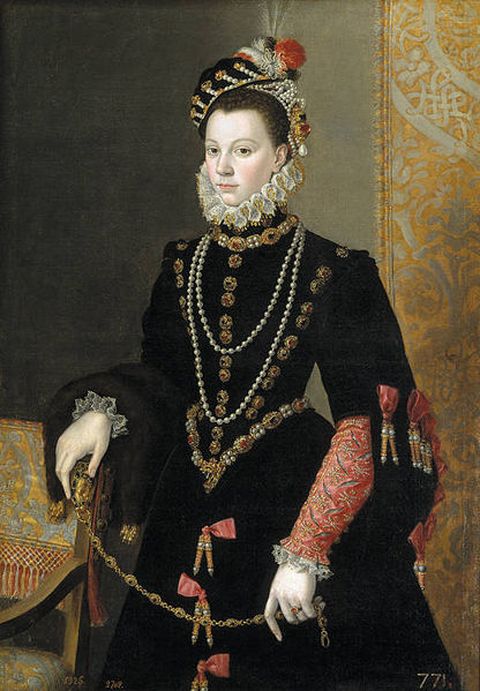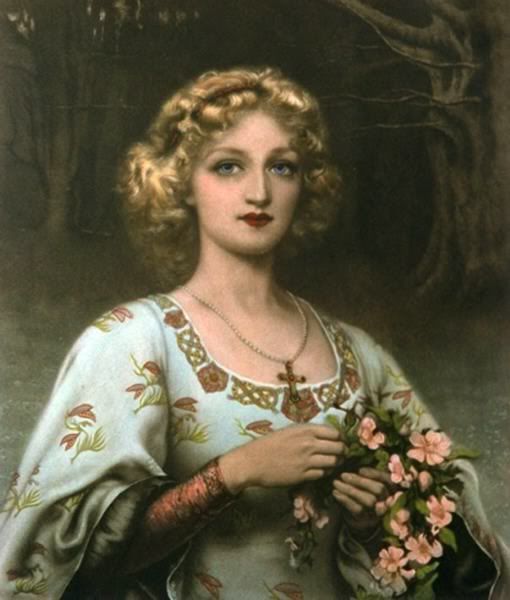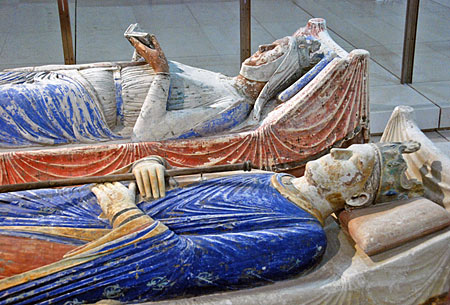Isabella of Castile was a shining example of queenship in the
late medieval age. The blue-eyed, reddish-blonde haired, fair skinned Queen of
Castile united the country of Spain with her husband, King Ferdinand II of
Aragon as well as fearlessly led her soldiers into battle. Isabella was quite a
woman – deeply religious and devout yet deviously ruthless; brave yet tender
towards her children; a woman of many talents and who wielded extreme
power.
Isabella was born April 22nd 1451 to King John II of
Castile and Isabella of Portugal in Madrigal de las Altas Torres Spain.
Isabella had two brothers; an older half-brother Enrique (Henry) and a younger
brother Alfonso. When her father died in 1454, when she was only 3 years old, her
older brother Henry became king of Castile and León as Henry IV. Isabella was
then raised by her mother in squalor until 1457 when Henry IV brought his
half-siblings to live with him at court where the conditions vastly improved.
Isabella was educated in many subjects: reading, spelling, writing, grammar,
mathematics, art, dance, music, embroidery and religion.
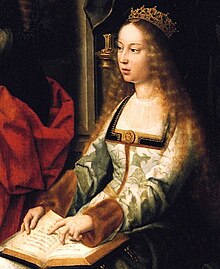
When Henry’s first marriage ended in divorce without children
and his second marriage produced only daughter Juana the opposition attempted
to replace Henry with Alfonso which in turn was met with defeat culminating
with Alfonso’s death by poison in 1468. The nobles attempt to take things into
their own hands and offered the crown to Isabella, who refused, but Henry
decided to compromise – he would make Isabella is heiress after the Battle of
Olmedo in 1467.
Since Isabella was his ward, Henry was able to do with her as he
pleased in terms of her future and there were many betrothals – all of which were
politically beneficial to him at the time. Isabella was betrothed to many men
including Ferdinand and Charles IV of Navarre, both sons of John II of Aragon;
and Alfonso V of Portugal to name a few. In the mist of all of the marriage
negotiations civil war broke out in Castile due to Henry’s inability to rule.
Perhaps if he focused a little more on matters of state and ruling his country
and a little less time on marriage negotiations for his sister, he would have
been able to rule properly and prevent civil war. But alas one must find the
perfect ally for the future, not matter what the costs. As you may imagine,
Isabella being a strong and independent woman, grew tired of waiting upon her
incompetent brother so she decided that she was going to marry Ferdinand of
Aragon without her brother’s permission. The two required a papal dispensation
as there was an issue of consanguinity (they were second cousins after all)
which was granted and the two married October 19th, 1469 in the
Palacio de los Vivero in Valiadolid.

Once Henry found out about his sister’s marriage he was enraged
to say the least – he even threatened to throw her into the dungeon, but of
course he could not due to her popularity with the nobles. Henry then withdrew
his recognition and again named his daughter Juana as his heiress. Upon Henry’s
death in 1474 a war of succession ensued with Alfonso V of Portugal supporting his
new wife Juana’s claims. The confusion over who was the right full queen of
Castile led to a long and bloody war – the war of the Castilian succession, until
the Battle of Toro took place and the war was finally settled in 1479 with
Juana denouncing her claim as queen and Isabella was recognized as Queen of
Castile and Portugal gained a favourable share of the Atlantic territories.

By this time Ferdinand was now King of Aragon and along with his
Castilian Queen, the two began the unification of Spain beginning with reducing
the power of the nobility and increasing the power of the crown as well as
rectifying the disastrous reign of Isabella’s predecessor Henry IV. The two
would rule Spain for 35 years, it would become known as a golden age for Spain.
Their marriage would produce 5 children; 4 daughters and 1 son: Isabella
(1470), Juan (1478), Juana (1479), Maria (1482) and Catherine (1485).
With the physical unification of Spain complete, Isabella and
Ferdinand embarked on a process of spiritual unification of their country as
well, their desire to bring Spain under one common faith: Roman Catholicism. Isabella
and Ferdinand began the Spanish Inquisition in 1480. The Inquisition was just
one of the many changes to the church the Catholic monarchs made in their country.
The Inquisition was aimed mostly at Jews and Muslims who had overtly converted
to Christianity but who were still practicing their own religions in secret, as
well as at heretics who rejected the Roman Catholic orthodoxy – it was intended
to maintain Catholic orthodoxy in the kingdoms.

Throughout the Inquisition, Isabella fought alongside her
husband and the couple lived in tents along with their soldiers instead of in
cozy palaces. They spent years on crusade attempting to rid their beloved Spain
of Jews, Muslims and those who were not of the Catholic faith, burning them as
they went in the name of God. The Catholic monarchs began on a series of
campaigns known as the Granada War which began with the attack of Alhama de
Granada – the city fell in 1482 and after 10 years of many battles the Granada
War ended in 1492 when the Moors handed over the keys of the Alhambra Palace to
the Castilian soldiers. The Moors were actually pretty darn lucky – they were
treated way better than the Jews as they were actually allowed to practice their
own religion and were exempt from taxes for many years thanks to the Treaty of
Granada.
 |
| Surrender of the Moors |
Ferdinand and Isabella ordered the expulsion of all Jews and
Muslims from Spain – many converted to Catholicism as a way of avoiding
expulsion but many of the conversos were accused of secretly practising their
original religion and they were arrested, imprisoned, interrogated under
torture and in many cases burned to death. Finally in 1492 the Catholic
monarchs created the Alhambra Decree which ordered the expulsion of Jews from
the Kingdoms of Castile and Aragon. The Jews were given 4 months to vacate
Spain or to convert – tens of thousands of Jews abandoned Spain in favour of
other lands to whom Ferdinand would address a letter later that year, you are
welcomed to return to Spain as long as you become Christians. The Muslims were
given the same orders – either convert or leave Spain; the other choice was
death. They were just a little harsh weren’t they . . .
Isabella and Ferdinand also brought Spain their “golden age” by
funding Christopher Columbus’ adventure to find India . . . or at least to find
America and other lands, he never did find India, maybe he should have sailed
in the other direction . . . Despite his failure to reach India, Columbus did
find a land rich with gold, silver and spices and declared her for Spain. This
land is what we know as Cuba and Columbus thought that it was located somewhere
in Asia and that the island of Hispanola (modern day Dominican Republic and
Haiti) was just off the coast of China. Maybe Isabella and Ferdinand should
have bought Columbus a better map and compass. Anyways, that’s beside the
point, point is that the Catholic monarchs grew undoubtedly richer from
Columbus’ travels – he brought them back treasures of all kinds; agriculture,
cloths, glass, steel weapons and leather goods – all in thanks for their
funding. Isabella was made protector of the Native Americans and she
established laws against the abuse of the Native American people by colonists
and adventures.
 |
| Isabella and Ferdinand receiving Columbus |
Isabella’s later life was filled with grief – the deaths of her
daughter Isabella and her son Juan as well as her grandson Miguel. Isabella
officially withdrew from governmental affairs in September 1504 and she died
that same year in November in Medina del Campo. Upon her death, her crown of
Castile passed on to her daughter Juana.
